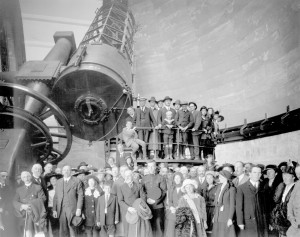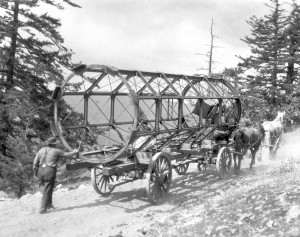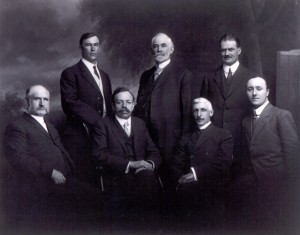1914: AN OPPORTUNE TIME TO FORM A CENTRE
A FAILED ATTEMPT
- VICTORIA was very early on the scene as far as Centres go. In fact, as early as 1907 a meteorologist by the name of E. Baynes Reed, who was working for the federal Meteorological Service weather station in Victoria, joined the RASC at the suggestion of his assistant, F. Napier Denison, who looked after the seismic equipment and the data. Baynes-Reed began establishing a Centre on the Island, arranging for meetings in 1907 with a small group, which consisted of the more influential citizens in the Victoria community.
By 1909 some 20 members in the Victoria area were on record with the RASC but they were members in name only and for some unknown reason never met together. Consequently, in 1910 a letter was sent to head office in Toronto stating that the Centre was closing down and all fees collected by the Centre were being refunded.
THE TIME IS RIPE TO START A NEW CENTRE
- In 1914 Mr. W. E Harper and Dr. J. S. Plaskett of the Dominion Observatory in Ottawa had visited Victoria in connection with the establishment, on Little Saanich Mountain, of a great observatory enclosing a 72-inch reflecting telescope. It was intended for this telescope to become the largest in the world at that time. Unfortunately, circumstances caused it to lose out to a rival. All these matters were receiving avid attention in Victoria’s and the world’s daily press.
1914 VICTORIA CENTRE COUNCIL
Back row, left to right: E. H. Cotterell, C.E.; Secretary-Treasurer; A. W. McCurdy; Vice-President; Major C. B. Simonds, C.E.
Front row: W. J. Sutton, M.E.; Dr. J. S. Plaskett, P.R.A.S. of C., Honorary President; T. Napier Denison, President; G.G. Aiken.
Conditions favourable for the formation of the Victoria Centre did not come easily. They were the result of the energy and initiative of a few public-spirited men, notably Mr. F. Napier Denison, Mr. W. J. S. Sutton and Mr. W. A. McCurdy, who was a past president of the Natural History Society of B.C. and a member of the RASC.
In 1913 Dr. Plaskett, who was then visiting Victoria to lead the construction of a telescope and observatory, was invited to address a public meeting held on the 4th March, under the auspices of the Natural History Society. In his address Dr. Plaskett spoke of the cultural advantages accruing to the city from its becoming a Centre of the RASC. The idea was enthusiastically received and at a second public meeting, held on Friday, March 6, the present Victoria Centre was formed. The minutes of this historic meeting read as follows: “The meeting being called to form a Centre of The Royal Astronomical Society in Victoria and as Dr. Plaskett was present the chairman called upon him to explain the objects of a Centre of the Royal Society.
Twenty of those present indicated that they would like to become members of RASC whereupon “the chair announced that the creation of officers would now take place.
Other members quickly joined and 48 became charter members. By April 14, 1914 the Centre secretary was able to report: “I have today received a letter from Mr. Cotterell announcing the formation of the Victoria Centre together with a list of 58 members and a draft of $116 covering their fees for the current year.
THE PLASKETT TELESCOPE’S CONSTRUCTION
- A Vancouver firm, the McAlpine Robertson company, built the building that houses the dome for $75,000. Warner & Swasey in Cleveland, Ohio built the telescope.
- The 1.8-m crown glass disk, weighing 2000 kilograms, was made by the Saint-Gobain company in their Antwerp, Belgium, glass works and was shipped to America only one week before the outbreak of World War I.
- Mirror grinding for the 1.8-m was undertaken by the John A. Brashear company in Pittsburgh. However, it had to be reground on two more occasions, once due to an unexplained scratch and another due to a grinding flaw. Regrinding delayed first light for two years until May 6 1918.
- Eventually, the completed mirror and telescope were hauled on wagons by teams of horses up the winding Little Saanich Mountain Road.

1918: OFFICIAL OPENING OF THE OBSERVATORY
After the installation of the 72-in. mirror the Lieut-Governor of British Columbia, Sir Frank Barnard (bottom left, with a coat over his arm), opened the observatory officially on June 4, 1918. A great crowd of visitors, among them many Centre members, attended this notable occasion at the opening of what should have been the largest telescope in the world at that time.
Unfortunately, flaws in the mirror caused repeated grindings lasting two years thereby permitting the larger 100” Hooker Telescope on Mt. Wilson to have first light six months before the DAO.
Dr. John S. Plaskett (third from the left with hat in hand, front row) is accompanied by a number of dignitaries, observatory staff, their families, and members of the Victoria Centre.
Earlier, on January 8, 1918, Dr. Plaskett announced that the Geographic Board of Canada had approved his suggestion to rename Little Saanich Mountain as Observatory Hill.

Hauling prefabricated parts to the top of the Hill.
